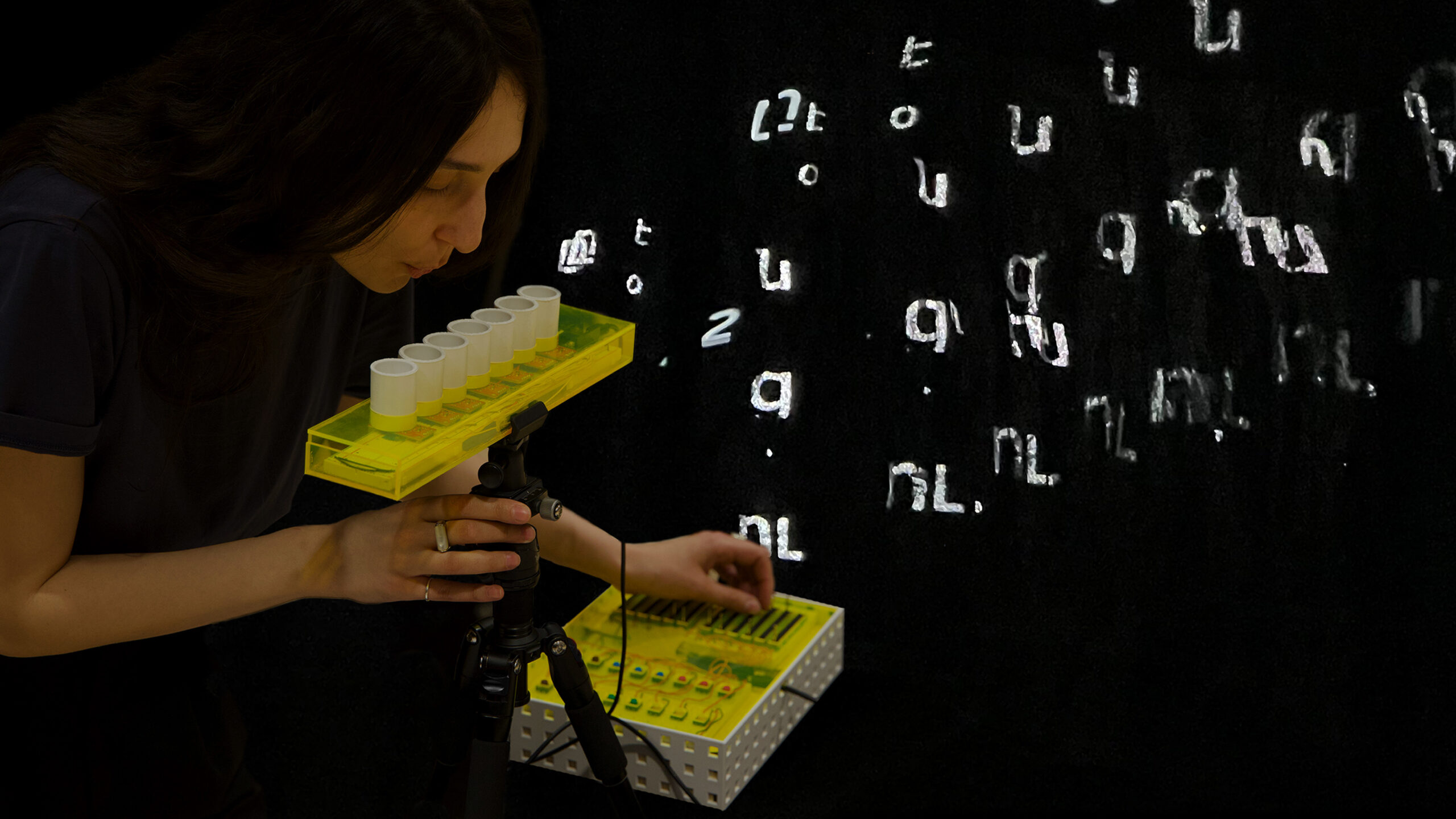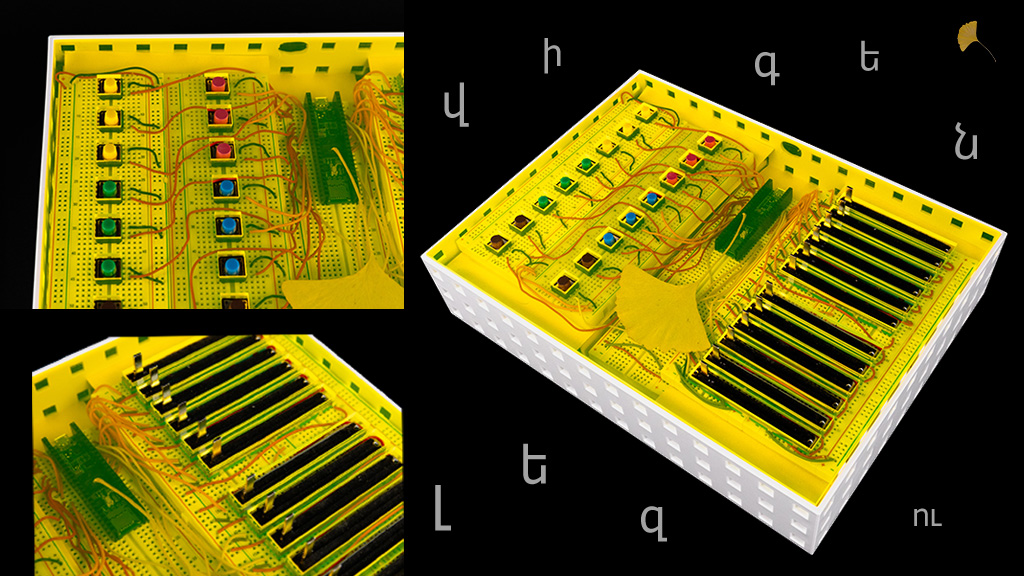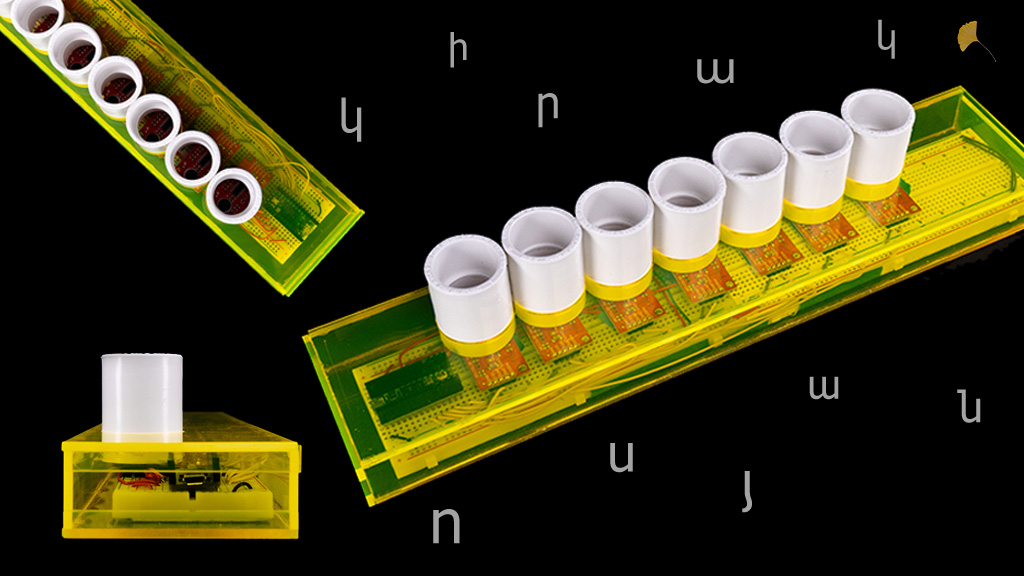LEZU
Lusine Kirakosyan
Advisor: Theo Ellin Ballew
This audiovisual project transforms the 39 letters of the Armenian alphabet into melodies, blending cultural heritage with modern technology and sound design. My goal is to foster deeper understanding and empathy between people from different cultures, because the more familiar you are with a culture, the more you care about its people.

Project Description
I’ve created an instrument that produces sound and visuals together in real time. Each Armenian letter comes alive visually as you play, turning language into an interactive, multisensory experience.
Armenia has changed a lot through the centuries—borders shrinking, names erased, colors fading. When I look at its history, I see less and less. In 2023, we lost Artsakh. Again. The very place where the first Armenian school was established. This reminds me of Samvel, an Armenian novel by Raffi, which also inspires my project. In the 5th century, during another time of instability, Mesrop Mashtots created the Armenian alphabet in 405 AD and opened the first school in Artsakh’s Amaras Monastery. Language became not only a tool for writing but a way to protect identity—a tool for survival.
That idea stayed with me. It made me wonder: if Mashtots used the tools of his time to preserve our culture, what are the tools we have now? LEZU is a response to that question. It’s a reimagined alphabet, an instrument, and a platform. It transforms language into melodies and visuals—something you can play, see, and feel.
As I worked on this project, I realized I wasn’t just designing a new system of communication, but also building a community. LEZU is open to musicians, artists, writers, and technologists—anyone who wants to collaborate, connect, and create.

Technical Details
The project consists of two main components: one inspired by a MIDI controller and the other by the duduk, a traditional Armenian woodwind instrument. The MIDI-style and Duduk-style instruments are housed in transparent acrylic, symbolizing openness and clarity, values that are essential to meaningful communication. Transparency allows the audience to see the inner workings of the instrument, reinforcing the idea of cultural and technological openness.
The MIDI-style controller includes 12 sliders assigned to vowels and vowel-like consonants, letters in the Armenian alphabet that can function as vowels depending on their phonetic context. It also features 16 buttons representing the remaining consonants, each mapped to rhythmic sound patterns that correspond to specific Armenian letters. This enclosure measures 11" × 8.25" × 2.5".
For the duduk-inspired section, I used 7 vowel-like consonants because these letters sound like whistling or windy noises. Sound detectors capture the air pressure and trigger the corresponding sounds. Its enclosure measures 13.75" × 3" × 2.5".
Both components are powered by separate Teensy microcontrollers, interfacing with sliders, buttons, and sensors to generate audio and visual output. The sound is processed through Ableton Live, visuals are handled in TouchDesigner, and projection mapping is done with MadMapper.
For the typography, I used the Tahoma Armenia typeface.
The projection was displayed on eight layers of tulle fabric, each measuring 118" × 78.7", spaced 20" apart. The installation was presented in NYU's Media Commons space, which measures approximately 33.2' × 24.1'.

Research/Context
Samvel by Raffi
https://www.wikiwand.com/en/articles/Samuel_(novel)
https://vahagnakanch.wordpress.com/wp-content/uploads/2011/04/raffi-samvel.pdf
Thomas Bloch – Cristal Baschet
https://www.thomasbloch.net/en_cristal-baschet.html
Sankyo 20-note Instrument
https://www.leturlutain.fr/index.php?item=mecanisme-20-notes-sankyo&action=article&group_id=10000031&aid=5794&lang=fr
Frédéric Bruly Bouabré at MoMA
https://www.moma.org/calendar/exhibitions/5348
Armenian Alphabet – Wikiwand
https://www.wikiwand.com/en/articles/Armenian_alphabet
The Armenian-Artsakh Connection
https://agbu.org/artsakh-strong/armenian-artsakh-connection
https://www.instagram.com/p/DI1MROMJCn_/?img_index=1
https://www.civilnet.am/en/news/754583/historical-revisionism-and-the-republic-of-artsakh/
Amaras Monastery
https://www.wikiwand.com/en/articles/Amaras_Monastery
https://www.instagram.com/p/CxaCIiwOjKP/
Tigran Hamasyan-The Cave of Rebirth
https://www.youtube.com/watch?v=KtMDfBPghgE